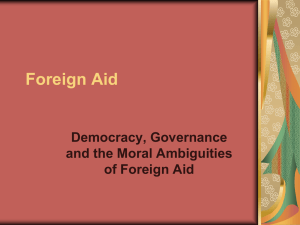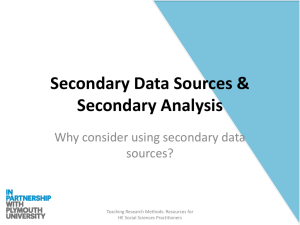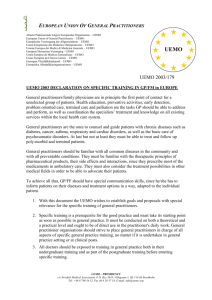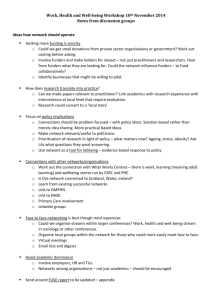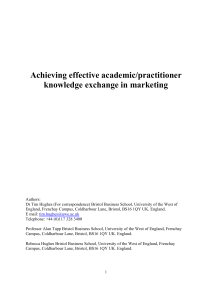Keynote Speech by Associate Professor Kim Fam “Marketing in Asia
advertisement
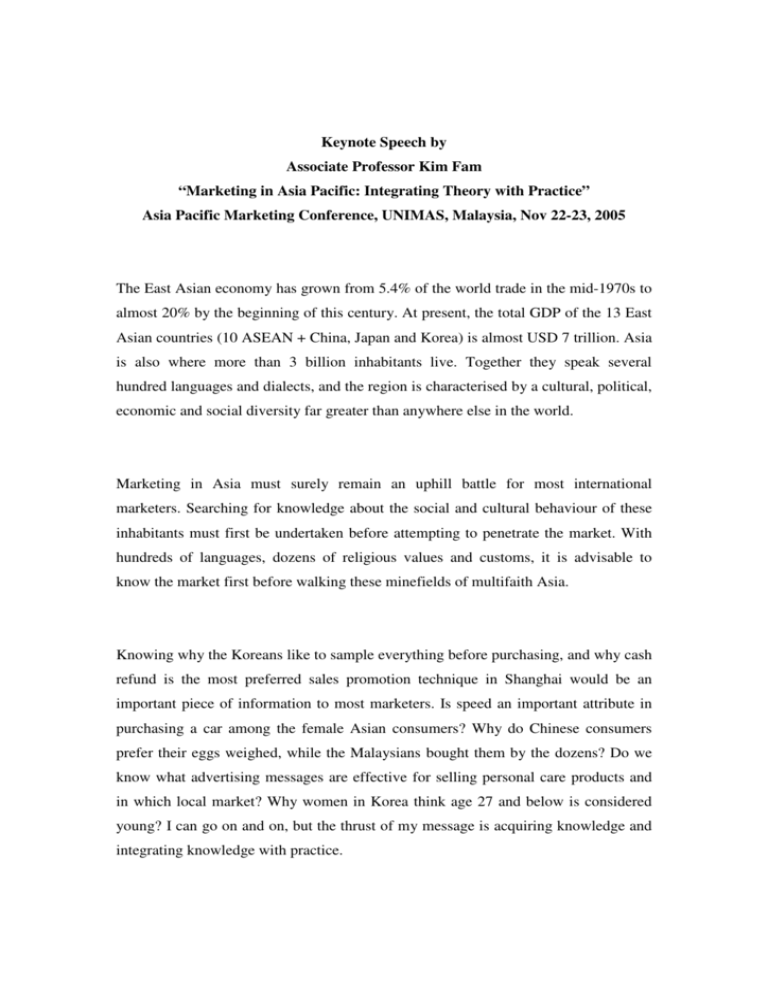
Keynote Speech by Associate Professor Kim Fam “Marketing in Asia Pacific: Integrating Theory with Practice” Asia Pacific Marketing Conference, UNIMAS, Malaysia, Nov 22-23, 2005 The East Asian economy has grown from 5.4% of the world trade in the mid-1970s to almost 20% by the beginning of this century. At present, the total GDP of the 13 East Asian countries (10 ASEAN + China, Japan and Korea) is almost USD 7 trillion. Asia is also where more than 3 billion inhabitants live. Together they speak several hundred languages and dialects, and the region is characterised by a cultural, political, economic and social diversity far greater than anywhere else in the world. Marketing in Asia must surely remain an uphill battle for most international marketers. Searching for knowledge about the social and cultural behaviour of these inhabitants must first be undertaken before attempting to penetrate the market. With hundreds of languages, dozens of religious values and customs, it is advisable to know the market first before walking these minefields of multifaith Asia. Knowing why the Koreans like to sample everything before purchasing, and why cash refund is the most preferred sales promotion technique in Shanghai would be an important piece of information to most marketers. Is speed an important attribute in purchasing a car among the female Asian consumers? Why do Chinese consumers prefer their eggs weighed, while the Malaysians bought them by the dozens? Do we know what advertising messages are effective for selling personal care products and in which local market? Why women in Korea think age 27 and below is considered young? I can go on and on, but the thrust of my message is acquiring knowledge and integrating knowledge with practice. Knowledge is for Sharing. Knowledge is Alive I believe that knowledge is meant to be shared. Sharing knowledge does not diminish its value to its creator. Thomas Jefferson (1813) said: “He who receives an idea from me receives instruction himself without lessening mine; as he who lights his taper at mine, receives light without darkening mine. That idea should freely spread from one to another over the globe, for the moral and mutual instruction of man, and improvement of his condition”. What kind of knowledge does the business community want and through which media can this knowledge be effectively transferred to improve the community’s condition? Knowledge is useful information that is new to the user. It can be acquired through observation of own decisions and activities, observation and imitation of competitors or through channels like attending presentations, reading the research literature and interacting with others such as managers and consultants. But studies showed the academic outputs (concepts and theories) are not reaching the intended readers. There are claims that the intended audience of most research is the academic community talking to themselves rather than the dual community of scholars and practitioners. There are some truths in it. While professors discover concepts and theories, students learn. However, if that knowledge is not effectively communicated beyond the four walls of a classroom (ie. to the business community), that knowledge becomes a museum piece. A number of barriers to knowledge transfer include the research findings were not written in plain English and with jargon and terminology (Crosier, 2004; Ottesen and Gronhaug, 2004), time lag as practice usually preceded theory development (O’Driscoll and Murray, 1998), poor understanding of commercial realities and using the wrong media to deliver the knowledge. Knowledge is alive and constantly updating. Knowledge exists in two forms: lifeless stored in books, and alive - in the conscious of men (Perley, 2005). Through their research, academics continuously discover new concepts and theories. It is this ‘alive’ knowledge that is meant for sharing. But if the practitioners continue to view academic research as arcane, irrelevant and trivial, then the new found knowledge will forever remain on the museum shelves. Similarly, it would be helpful if the practitioners take a positive view of the marketing discipline and the research outputs. It is myopic to say that only researchers use theory and academic research findings are just common sense. I disagree that the marketing function is one performed through art and experience or from contacts in the industry. I think the practitioners’ negative view is more to do with a misunderstanding of theory than their belief that theorising is irrelevant, academic pastime. As stated earlier, the irrelevance could relate to the language and mode of delivery of the research findings to the practitioners. Theory and Practice do make Good Bedfellows The Asian market is both a minefield and a honey pot. A minefield because there are many different cultural values, beliefs and practices among its inhabitants, and a honey pot as the region is fast becoming the economic power of the world. The recent ‘Economist’ magazine claimed that the world’s monetary policy is now being hatched in Beijing rather than in Washington. With the onslaught of globalisation, to stay competitive is to stay ahead of your competitors. This can mean acquiring knowledge. By knowledge I mean theories, models, concepts, techniques and facts that are often used to describe and explain phenomena, as well as predict developments and outcomes. Multiple models exist in the marketing discipline. The usefulness of these models was communicated to students via the classroom or disseminated to the community via seminars and publications. These models include SWOT analysis; product lifecycle; positioning; consumer buying decision process; segmentation; Porter’s Five Forces model; and the BCG matrix. There are not many of us here know their application. Did you know that Porter’s five forces model is used to describe and understand market competition as a basis for competitive moves, while the BCG matrix is useful for capturing the firms’ product portfolios as a basis for future harvest and investment decisions? Furthermore, did you know that insensitivity to local customs and values is the primary underlying cause of consumer discontentment? If the answer is ‘No’, perhaps it is time that the university and the business community joint forces to improve each other’s condition. Theory and practice do make a good bedfellow. As academic research is often carried out scientifically, rather than relying entirely on common sense, applying these findings could benefit the practitioners. For instance, Haier, the white goods manufacturer from China, decided to manufacture more washing machines that can wash potatoes for rural farmers than clothing when the former through scientific research found that washed potatoes fetched more money for the farmers than unwashed. Another example of working closely with academics is Whirlpool, the world’s largest appliance maker. In order to capture a share of the washing machine market in the Chinese countryside from Haier, it started working closely with a local university researcher. Through market research, Whirlpool was able to allay consumers’ fear by convincing them that the company will be there to service machines. This is clearly the case of linking the marketing concept of cognitive dissonance (feel guilty or unsure after a purchase) with consumers’ pre-purchase behaviours. In Korea, Enprani cosmetic manufacturer, instead of using an age band, decided on being more specific by focusing on women aged 27 and below which according to Enprani aging quicken after 27. This is in line with the present segmentation theory that it is difficult for a company to communicate with both 25 years old and 65 years old. By focusing on young women, Enprani is able to focus on their values, that is, to stay forever young. Academics identified the Generation ‘Y’ consumers as optimistic, connected, experiential, and want immediate gratification. The information are then ‘transferred’ to makers of ‘Red Bull’, ‘Pepsi’, ‘General Motors’ and ‘Coca-Cola’. Consequently, these companies are putting in place ‘experience based, access driven marketing’ strategy (NZ Marketing Magazine, 2003). The crux of this strategy is that the marketer is no longer concerned with customer satisfaction. Instead he/she is with concerned with making the consumer emotionally attached to the product. Creating a relationship with the customers through participation in unique events is the essence of 21st century marketing. Looking ahead, this strategy is worth pursuing in Asia as the region has an expanding middle class population coupled with deep pocket parents with one or two children. How to Make Good Bedfellows? Integrating teaching, research and training to the benefit of the business community should remain the focus of a university. Similarly the business community should ‘open’ up their doors. Invite scholars to their premises to learn about their practices. What academics and practitioners in the industries need to do is work more closely together in order that theory has more direct relevance to firms. Academics should reach out to the industries to educate themselves of the real world practices. In return for the education, academics should synthesise what they have learnt into hypotheses and return this gift of knowledge to the business community. At City University of Hong Kong, all MBA students undergo a compulsory 10-day residential trip in China where they faced ‘reality’. Each group was given a real problem encountered by the case company. They were then asked to prepare solutions to address the problems using the theories and concepts they learnt in class. The winner will be the group whose solutions are adopted by the company’s management. Opening the ‘doors’ to the academic community is easier said than done. Already it is becoming more and more difficult to engage marketing practitioners in granting interviews and completing questionnaires, opening the doors to academics would be a huge ask. My own research typically involved members of the business community. For instance, I collaborated with Lowe Advertising (HK) Ltd on ‘What drives advertising likeability in Asia? I was involved in this project from day one. From questionnaire design straight to country selection, age group and sample size. In the end, a report was written with Lowe Advertising implementing most of what I recommended. From my experience, what makes a good bedfellow is choosing a topic that is of mutual interest. One of my current research themes is ‘when a goodbye is a good buy’. In this study I am interested in finding out which sales promotion technique accords the most purchase satisfaction in Asia. In an environment where there is high ad clutters, fragmented media and cultural minefields, marketers are more inclined to explore the effective use of sales promotion technique that moves stocks. Similarly, my second theme relates to ‘marketing the brains business.’ It is estimated that the Asian students business (ie. brains business) in New Zealand is worth over NZ$1 billion. Naturally, tertiary institutions providers are keen to work with researcher in finding out which promotional messages would entice these generation ‘Y’ students to their institution given that students with different cultural backgrounds prefer certain messages over others. I must admit, some things are hard to teach. You can teach and learn concepts and theories but that doesn’t mean that you will necessarily be able to work using those. What is meant by this is that to know how to apply knowledge, you have to learn the practices. To this end, I implement ‘Action Learning’ projects in my graduate classes. For instance, I tell my advanced international marketing students about Asian cultural theory and its impact on some aspects of marketing. In return, these students will undertake a project with preferably an exporting company and fixing the company’s international marketing problems with solutions they learnt from classroom. I found using Action Learning project enriches students with hands-on experience of what they would encounter in Asia. There is a general feeling that the practitioners are unable to access the knowledge discovered in academic research. My guess is if research in marketing is to have a major impact on practitioners, it must do much more than produce publications in academic journals. The practitioner community must be encouraged to come forward to reward and assess the quality and applicability of the research. To do this, the research outputs must be conveyed to the practitioners via media alternative to the academic journal like magazines, newspapers, radio, television and the Internet. In New Zealand, practitioner oriented magazine like NZ Marketing Magazine which reaches both the students and marketing practitioners remains a good conduit for new marketing knowledge. Knowledge exchange can also be achieved through social activities like spending time together or learning together. Sharing knowledge and knowledge acquisition are important factors for organisational success, and strategic alliances are viewed as increasingly important methods of acquiring knowledge (Marshall, Nguyen and Bryant, 2005). Multifaith Asia is like a minefield. A wrong move could give your competitors an advantage. My advice is to the practitioner community is to form partnership with a university. Trust between partners has been proposed as an important factor for acquiring and sharing knowledge. You got to trust your partner by sharing what you know. In return, you might gain even if only to reduce expensive mistakes and learning an efficient way of running the business. Is knowledge created or waiting to be discovered? Your position will determine the extent of knowledge transfer. If knowledge is created, then the transfer maybe a little problematic as practitioners think marketing is science and theorising is academics’ pastime. Alternatively, if knowledge is there to be discovered, then there will be a dual urge to discover, learn and transfer of ‘new’ knowledge between academics and practitioners. I leave it for you to discuss. Thank you for your attention. Kim Shyan Fam, PhD Associate Professor - University of Otago, Dunedin, New Zealand Adjunct Professor – Huazhong University of Science and Technology, Wuhan, China Visiting Professor – Szechenyi Istvan University, Gyor, Hungary References Crosier, K., (2004), How effectively do marketing journals transfer useful learning from scholars to practitioners?, Marketing Intelligence and Planning, vol. 22, no. 5, pp. 540-556. Marshall, R. S., Nguyen, T. V. and Bryant, S. E. (2005), ‘A dynamic model of trust development and knowledge sharing in strategic alliances’, Journal of General Management, vol. 31, no. 1, pp. 41-57. NZ Marketing Magazine (2003), ‘Think again: why experiential marketing is the next big thing’, Sept., pp. 8-15. O’Driscoll, A. and Murray, J. (1998), ‘The changing nature of theory and practice in marketing: on the value of synchrony”, Journal of Marketing Management, vol. 14, no. 5, pp. 391-416. Ottesen, G. G. and Gronhaugh, J., (2004), ‘Barriers to practical use of academic marketing knowledge’, Marketing Intelligence and Planning, vol. 22, no. 5, pp. 520530. Perley, C. (2005) “Time to reconnect the theory and practice”, Otago Daily Times, September 23.


